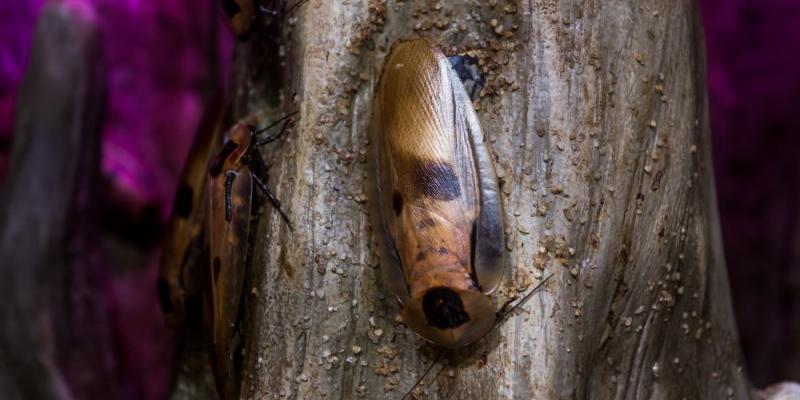Palmetto Bug vs Cockroach: What Sets Them Apart?

What’s the difference between a palmetto bug vs cockroach? In the Southeastern United States, the palmetto bug is actually a regional nickname for either the American Cockroach, or the Smokybrown Cockroach.
Understanding the distinctions between palmetto bugs and bugs that look like roaches can help you a ton when weighing your pest control options. This article will hopefully shed light on what sets them apart, and help you accurately identify these beastly bugs in your Florida home.
If you’re dealing with a roach (or a Palmetto problem), contact Orange Pest Control for professional assistance. Reach out today for a free quote!
What’s a Palmetto Bug?
In the Southeastern United States, the term "Palmetto Bug" serves as a regional nickname for certain types of cockroaches, primarily referring to two specific species: the American Cockroach and the Smokybrown Cockroach. Here’s what these bothersome buggers look, act, and eat like:
American Cockroach (Periplaneta americana):
- Appearance: Adults are large, winged, with a dark brown body and a cream-colored prothorax featuring dark markings reminiscent of sunglasses.
- Habitat: Prefer damp conditions and are often found in sewers, woodpiles, and mulch.
- Behavior: Attracted to lights and capable of flying towards them.
Smokybrown Cockroach:
- Appearance: Adults display a dark mahogany color and are winged but lack the "sunglasses" markings on the prothorax.
- Size: Slightly smaller than the American Cockroach, but bigger than the smallish German Cockroach.
- Commonality: These roaches are a bit less common than American or German Cockroaches.
Unlike other cockroach species, Palmetto Bugs can emit a foul spray, earning them nicknames such as the Florida Stinkroach or Skunk Roach. Despite their unappealing habits, including contaminating food and carrying diseases like salmonella, understanding these characteristics is crucial for effective identification and control.
What is a Cockroach?
Cockroaches, belonging to the order Blattodea which intriguingly includes termites, are one of the most adaptable and enduring insects on the planet. Their lineage traces back to the Carboniferous period, approximately 320 million years ago, showcasing their incredible survival through ages. Characterized by their flattened oval body, long antennae, and typically a shiny black or brown leathery integument, cockroaches have evolved into various species with distinct features and behaviors:
Species Appearance:
- American Cockroach: These roaches are an orangish brown
- Smokybrown Cockroach: Dark mahogany with a shiny appearance.
- German Cockroach: Smaller than most other roaches, a dark brown ovular appearance.
- Oriental Cockroach: Black with a glossy shine, similar in size to Smokey Browns.
Anatomy and Behavior:
- Body Structure: Small head, broad body, large compound eyes, and long antennae. The body is divided into a thorax of three segments and a ten-segmented abdomen, with two pairs of wings where the first pair serves as a protective cover.
- Habitat Preferences: Warm, humid environments, often found in human habitats due to the favorable conditions.
- Social and Feeding Habits: Cockroaches are social, nocturnal scavengers. They communicate using pheromones, are omnivorous, and can damage materials beyond their consumption needs, emitting a disagreeable odor.
Survival and Reproduction:
- Adaptability: Capable of surviving long periods without food or water and tolerating high levels of radiation.
- Reproduction: Females produce eggs in cases called oothecae, from which nymphs emerge and harden into adults. German Cockroaches are especially problematic due to their ability to carry around 45 bacteria and pathogens.
Key Differences Between Palmetto Bugs and Cockroaches
Palmetto bugs ARE cockroaches! Typically American, or Smoky Brown cockroaches To clarify:
Palmetto Bugs:
- Primarily associated with species such as the American cockroach (Periplaneta americana), Smokybrown cockroach, P. australasiae, P. brunnea, and Blaberus craniifer.
- These two species prefer warm, humid environments. You’ll find them in large numbers in the Southern United States, generally. Other roaches like German or Orientals are more common up North.
While the term "cockroach" encompasses a broad range of species with varied habitats and behaviors, "palmetto bug" narrows it down to those two specific types that thrive in certain Southern climates. These critters may be buggin’ out here in Florida, but don’t let them start an infestation!
Prevention and Control Tips
Preventing and controlling palmetto bugs and cockroaches requires a multifaceted approach to ensure these pests don't become unwelcome guests in your home. Here's how to keep them at bay:
Eliminate Food Sources & Reduce Moisture
- Store food in tightly sealed containers.
Clean spills and crumbs immediately.
- Fix leaky pipes and use a dehumidifier to reduce home humidity levels.
- Regularly take out the garbage.
Seal Entry Points & Reduce Hiding Spots
- Seal cracks and holes around the foundation, windows, and doors.
Keep mulch levels at 2-3 inches and away from the house foundation.
- Eliminate dark hiding spots by keeping areas around the home well-lit.
Natural & Chemical Control Methods
- Use peppermint oil spray, food-grade diatomaceous earth, or a mixture of sugar and borax for natural control.
- Spray roach repellent around the home and invest in bait stations.
- Encourage natural predators like beneficial insects and geckos.
Got a severe roach issue? Call a pest control company, since they have the skills and knowledge to fight these pests most effectively.
Conclusion
Building a sound, pest-free home in a Floridian climate that favors these resilient creatures can be pretty frustrating at times. By working on the measures listed in this article, you can take some significant steps in making sure your home is Palmetto bug free. If your Florida home is infested with cockroaches or palmetto bugs, Orange Pest Control is here to help.
